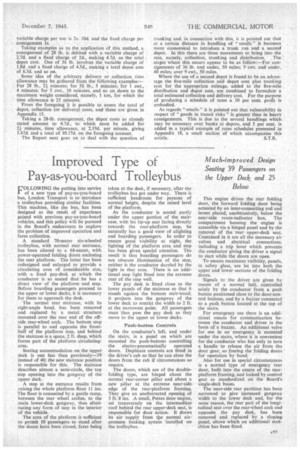Improved Type of Pay-as-you-board Trolleybus
Page 37

If you've noticed an error in this article please click here to report it so we can fix it.
Much-improved Design Sealing 39 Passengers on the Upper Deck and 25 Below
FOLLOWING the putting into service 1 of a new type of pay-as-you-board bus, London Transport is to introduce a trolleyhus providing similar facilities. This machine, like the bus, has been designed as the result of experience gained with previous pay-as-you-board vehicles, and this policy will be pursued in the Board's endeavours to explore the problem of improved operation and fares collection.
A standard 70-seater six-wheeled trolleybus, with normal rear _entrance, has been altered to a 64-seater, with power-operated folding doors enclosing the rear platform. The latter has been redesigned and enlarged to provide a circulating area of considerable size, with a fixed pay-desk at which the conductor is so seated that he has a direct view of the platform and step. Before boarding passengers proceed to the upper or lower decks, it is necessary for them to approach the desk.
The normal rear staircase, with its right-angle bend, has been removed and replaced by a metal structure mounted over the rear end of the offside rear-wheel arch. The bottom step is parallel to and opposite the fronthalf of the platform step, and behind the staircase is a space, 2 ft. deep, which forms part of the platform circulatingarea.
Seating accommodation on the upper deck is one less than previously-39 instead of 40; the new staircase position is responsible for this. The staircase describes almost a semi-circle, the top step opening into the gangway of the upper deck.
A step at the entrance results from raising the whole platform floor 11 ins. The floor is connected by a gentle ramp, between the rear wheel arches, to the main lower-deck gangway, thus eliminating any form of step in the interior of the vehicle.
The area of the platform is sufficient to permit 10 passengers to stand after the doors have been closed, fares being taken at the desk, if necessary, after the trolieybus has got under way. There is sufficient headroom for persons of normal height, despite the raised levet of the platform.
As the conductor is seated partly under the upper portion of the staircase, with his tip-up seat facing directly towards the rear-platform step, he naturally has a good view of alighting and boarding passengers. In order to ensure good visibility at night, the lighting of the platform area and step has been given special attention. The result is that boarding passengers do not obscure illumination of the step, neither is the conductor dazzled by the light in that area. There is an additional step light fitted into the extreme rear of the step well.
The pay desk is fitted close to the lower panels of the staircase so that it stands against the bottom stair-tread; it projects into the gangway of the lower deck to restrict the width to 2 ft. at the narrowest point. All passengers must thus pass the pay desk as they move to the upper or lower decks.
Push-button Controls On the conductor's left, and under the stairs; is a panel on which are mounted the push-buttons controlling the electro-pneumatically operated doors. Duplicate controls are fitted in the driver's cab so that he can close the doors from the cab if circumstances so require.
The doors, which are of the doublefolding type, are hinged about the normal rear-corner pillar and about a new pillar at the extreme near-side edge of the rear-platform framing. They give an unobstructed opening of 3 ft. 8 ins. A small, Peters door engine, set transversely on the intermediate roof behind the rear upper-deck seat, is responsible for door action. It draws its air supply from tile normal airpressure braking system installed on the trolleybus. This engine drives the rear folding door, the forward folding door being actuated by an inter-connecting rod and levers placed, unobtrusively, below the near-side route-indicator box. The compartment housingthe engine is accessible via a hinged panel and by the removal of the rear upper-deck seat. Contained in it are all the necessary air valves and electrical connections, including a trip lever which prevents the conductor giving the driver a signal to start while the doors are open.
To ensure maximum visibility, panels, in safety glass, are let into both the upper and lower sections of the folding doors.
Signals to the driver are given by means of a normal bell, controlled solely by the conductor from a push button positioned close to the door-control buttons, and by a buzzer connected ' to a push button located at the top of the stairs.
For emergency use there is an additional means for communication between the conductor and driver in the form of a buzzer. An additional valve for use in an emergency is mounted under the stairs, where it is convenient for the conductor who has only to turn a handle to release the air from the door gear, so freeing the folding doors ' for operation by hand.
Also for use in special circumstances is a normal type of emergency rear door. built into the centre of the rearplatform framing, and locked by control gear as standardized on the Board's single-deck buses.
The near-side rear partition has been narrowed to give increased gangway 'width to the lower deck and, for the same reason, the rear part of the longitudinal seat over the rear-wheel arch and opposite the pay desk, has been removed and replaced by a sloping panel, above which an additional stanchion has been fitted.




























































